Mantises require secure, well-ventilated enclosures that support their unique needs. Upcycled containers like clear food tubs, plastic bottles, or old jars can provide safe and stylish homes for mantises when prepared correctly. These options are affordable, eco-friendly, and make it easy to observe the insects’ fascinating behavior.
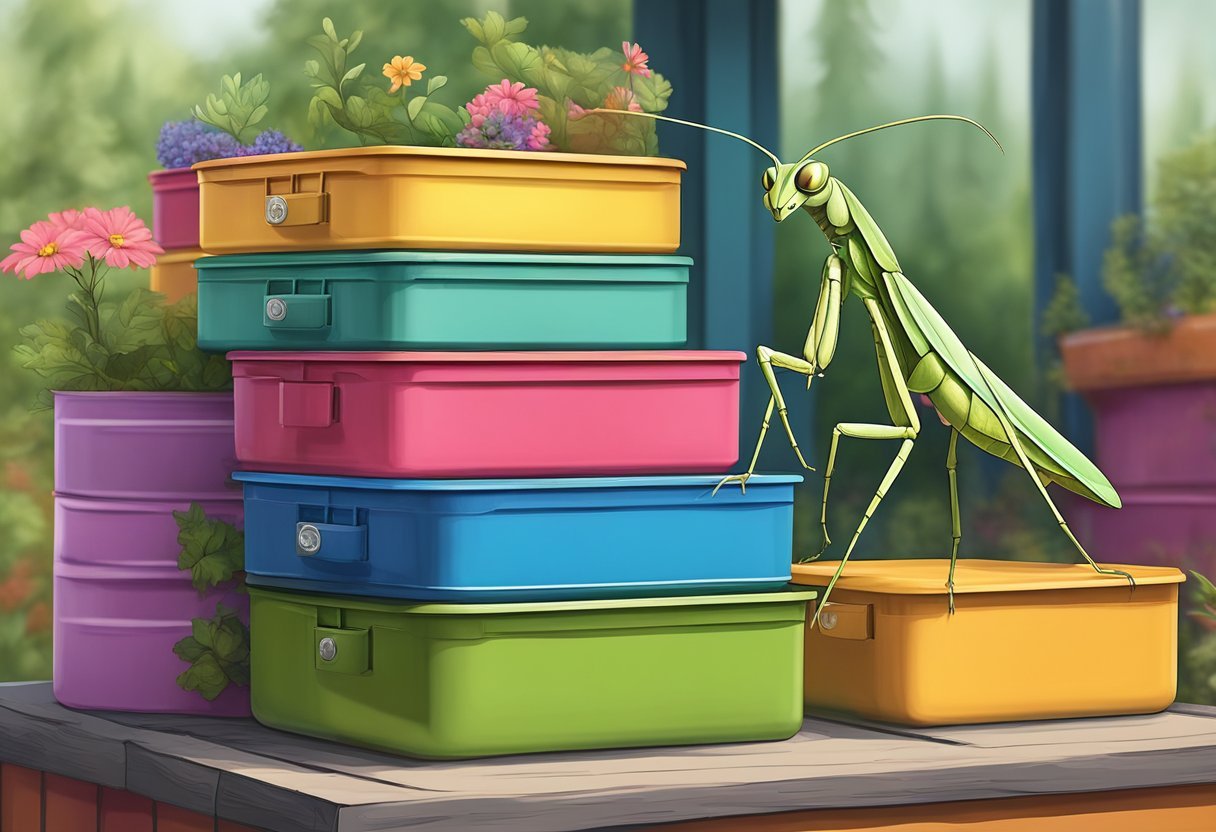
Choosing the right container size and ensuring proper airflow helps create a comfortable habitat. Adding simple modifications, such as mesh lids and natural climbing surfaces, transforms everyday items into ideal mantis enclosures. Readers interested in caring for mantises or reducing waste will find practical advice to get started with upcycled habitats.
Choosing the Best Upcycled Containers for Mantises
Upcycled containers can provide practical and eco-friendly enclosures for mantises. The best choices depend on material safety, adequate space, and freedom from toxic residues.
Understanding Suitable Container Materials
The material of an upcycled container impacts airflow, durability, and ease of cleaning. Plastic containers like jars, food storage boxes, and large water bottles are lightweight and easy to modify. Glass jars offer clear viewing and are sturdy, but they may require more careful handling.
Metal tins are less ideal due to poor ventilation and potential rust, especially in humid habitats. Cardboard breaks down quickly, absorbs moisture, and is difficult to sanitize, making it unsuitable for mantids’ needs.
Choose containers with smooth, unbroken surfaces to prevent cuts or injury. Clear sides allow for easy observation and light. Avoid containers that are heavily stained, scratched, or contain residues that are difficult to remove.
Sizing and Space Considerations
Mantises need enough space to molt and hunt without crowding. The container should be at least three times the body length of the mantis in height and twice in width. This minimizes risks of stuck molts and promotes healthier development.
For example:
| Mantis Size | Minimum Height | Minimum Width |
|---|---|---|
| 2 inches | 6+ inches | 4+ inches |
| 4 inches | 12+ inches | 8+ inches |
Ventilation holes are necessary to ensure proper air flow. Use a soldering iron or sharp tool to add holes but avoid making them so large that the mantis can escape. Vertical space is more important than floor area, especially for arboreal mantis species.
Selecting Non-Toxic and Safe Options
Always select containers that previously held non-toxic items. Avoid those that contained chemicals, cleaners, or unknown substances, as they may leave harmful residues. It is best to thoroughly wash and air-dry all containers before introducing a mantis.
Food-grade plastics are preferable due to consistent safety standards. Remove any old labels or adhesives, as these can be ingested or cause irritation. Disinfect containers using gentle, dilute soap solutions and rinse thoroughly.
Containers should also be free from sharp edges or cracks, as these can injure delicate mantis legs and bodies. If using containers with lids, ensure they are easy to open and close for maintenance and feeding without risking escape.
Preparing and Cleaning Upcycled Containers
Mantis keepers should ensure all upcycled enclosures are thoroughly prepared to prevent contamination and maintain insect health. Cleaning, sanitizing, and pest prevention are critical steps for using recycled materials safely.
Sanitizing Recycled Materials
Proper sanitation is essential before using any container for mantises. All surfaces should be cleaned with hot, soapy water, scrubbing away dirt, residue, and sticky labels. For added disinfection, containers made of glass or sturdy plastic can be soaked in a mild bleach solution (1 part bleach to 10 parts water) for ten minutes.
After soaking, rinse thoroughly with clean water to ensure no chemicals remain. Let the container air dry completely. Pay extra attention to lids, corners, and crevices where debris might get trapped. Do not use harsh cleaning products, as residue can harm insects. If possible, use new, disposable sponges or brushes to avoid cross-contamination.
Preventing Mold and Pests
To reduce mold risk, containers must be fully dry before introducing mantises. Ventilation holes—made with a heated pin, nail, or drill—help regulate airflow and humidity. Mesh screens can be glued over holes with a non-toxic adhesive to keep pests out.
Inspect all reused materials for insect eggs or hidden pests. Remove and discard contaminated parts immediately. Regularly check for mold growth and clean at the first sign using a mild vinegar or alcohol solution, letting the enclosure dry afterwards. Always quarantine new containers and substrates for several days before use to spot possible problems early.
Designing Safe Habitats in Upcycled Homes
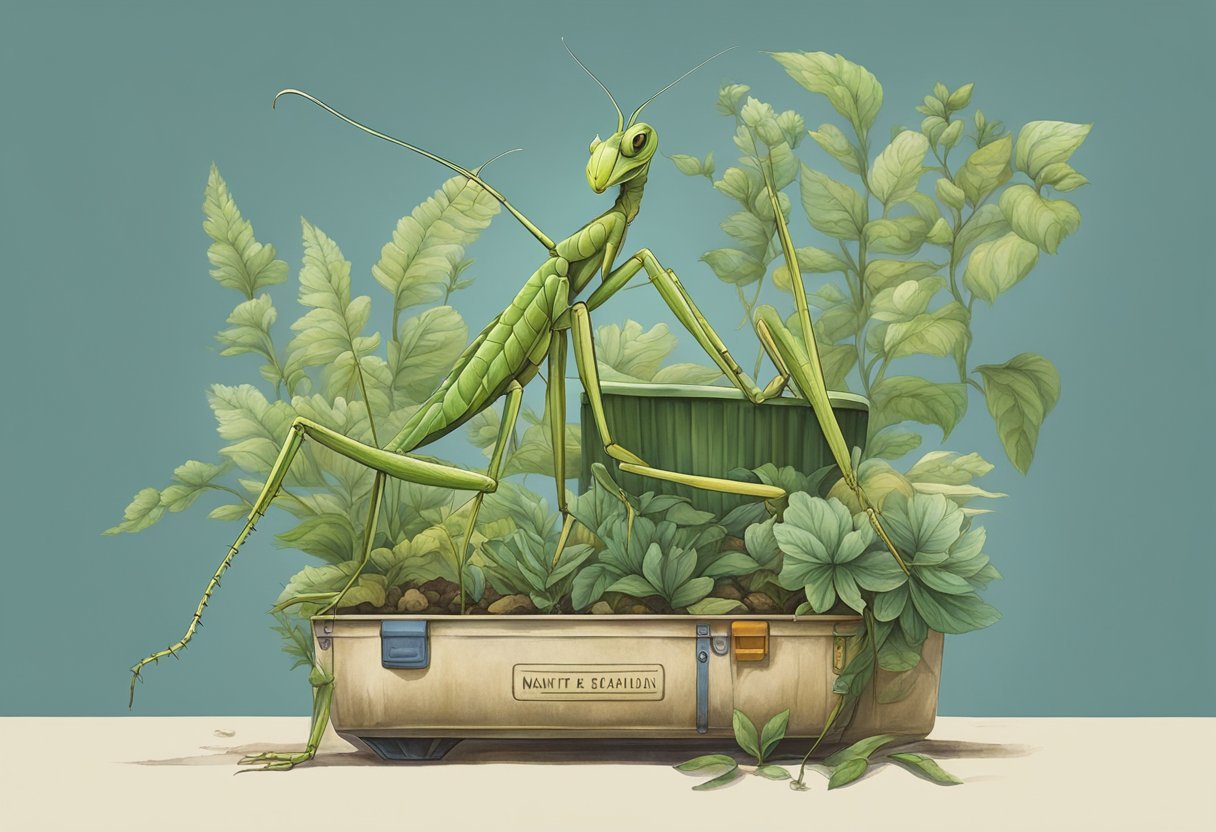
Upcycled containers require careful preparation to create environments that are both comfortable and secure for mantises. Success depends on managing ventilation, keeping openings secure, and maintaining stable humidity.
Ventilation and Airflow Essentials
Proper airflow prevents mold, reduces harmful bacterial growth, and supplies fresh air. Small mantises are especially vulnerable to poor ventilation, so making enough holes is crucial. Fine mesh or small-bore drill bits help provide airflow without allowing mantises to escape.
To avoid drafts, holes should be spaced evenly along the container’s sides or the lid. Ideal hole size:
- Pinhead- to L2 mantis: 0.5–1 mm
- L3 and larger: 1–2 mm
In recycled jars or bottles, the plastic or glass can be drilled, melted, or punctured. Using a soldering iron to melt holes can prevent cracks. Mesh glued over larger cutouts gives good ventilation for bigger species.
Securing Lids and Openings
Escape is a leading risk when keeping mantises in upcycled containers. Lids should fit snugly and resist tampering by curious insects or children. Screw-top lids are effective if regularly checked for wear.
Securing openings:
- Use fine mesh and hot glue to cover air holes.
- Add foam weatherstripping to loose-fitting lids for a better seal.
- Clips or binder clips can hold lids on larger containers like food tubs.
Door flaps cut in the side of plastic boxes offer easy access but should close tightly and be checked regularly for damage. Any feeding port or access door must be made with the same care as the main opening.
Moisture Control Techniques
Humidity is vital for mantis molting and health, but excess moisture can cause mold. The balance depends on species and local climate. Paper towels, coconut fiber, or sphagnum moss are common substrates for maintaining humidity in upcycled habitats.
Methods to manage moisture:
- Mist the enclosure lightly with a spray bottle, aiming for the container sides.
- Line the base with absorbent material, such as unbleached paper towel or moistened moss.
- Monitor with a simple analog or digital hygrometer for accuracy.
If condensation forms, increase the air holes or decrease misting frequency. Use shallow water caps only for older mantises to prevent drowning risks for nymphs. Always keep the container out of direct sunlight to avoid overheating and rapid moisture loss.
Creating Stylish and Functional Decor
Upcycling mantis containers can improve both the look and safety of a pet’s enclosure. Attention to material choice and arrangement ensures mantises have an environment that meets their needs while fitting into home decor.
Eco-Friendly Decoration Ideas
Sustainable decor involves using non-toxic, upcycled elements such as glass jars, plastic food containers, or wooden boxes. Natural items like cleaned twigs, leaves, and bark add interest without harming the mantis. Avoid using painted or chemically treated items, as residues can be toxic.
Decor can serve dual purposes. Reused mesh fabric can provide ventilation and climbing space. Cork sheets and cardboard create hiding places and allow mantises to molt safely. A simple table comparing safe and unsafe materials helps guide decisions:
| Safe to Use | Avoid |
|---|---|
| Glass, acrylic | Metal (rust risk) |
| Food-grade plastic | Painted surfaces |
| Natural wood (untreated) | Chemically treated wood |
Even embellishments, such as pebble bases or moss, should be sourced organically and cleaned before use.
Blending Aesthetics with Utility
Functionality should not be sacrificed for visual appeal. All decor must support essential behaviors, like climbing, hiding, and shedding. For example, vertical branches encourage climbing, while leafy areas offer shelter.
Minimize clutter, as too many items may trap or stress the mantis. Containers with clear sides allow for easy observation, and removable backgrounds let owners update the look without disturbing the enclosure. Magnetic or clip-on decor can simplify cleaning and rearrangement.
Proper lighting highlights the container’s design but should not overheat the habitat or stress the mantis. Consider the scale of decoration. Each item should fit the mantis’s size and allow easy movement throughout the container.
Customizing for Species-Specific Needs
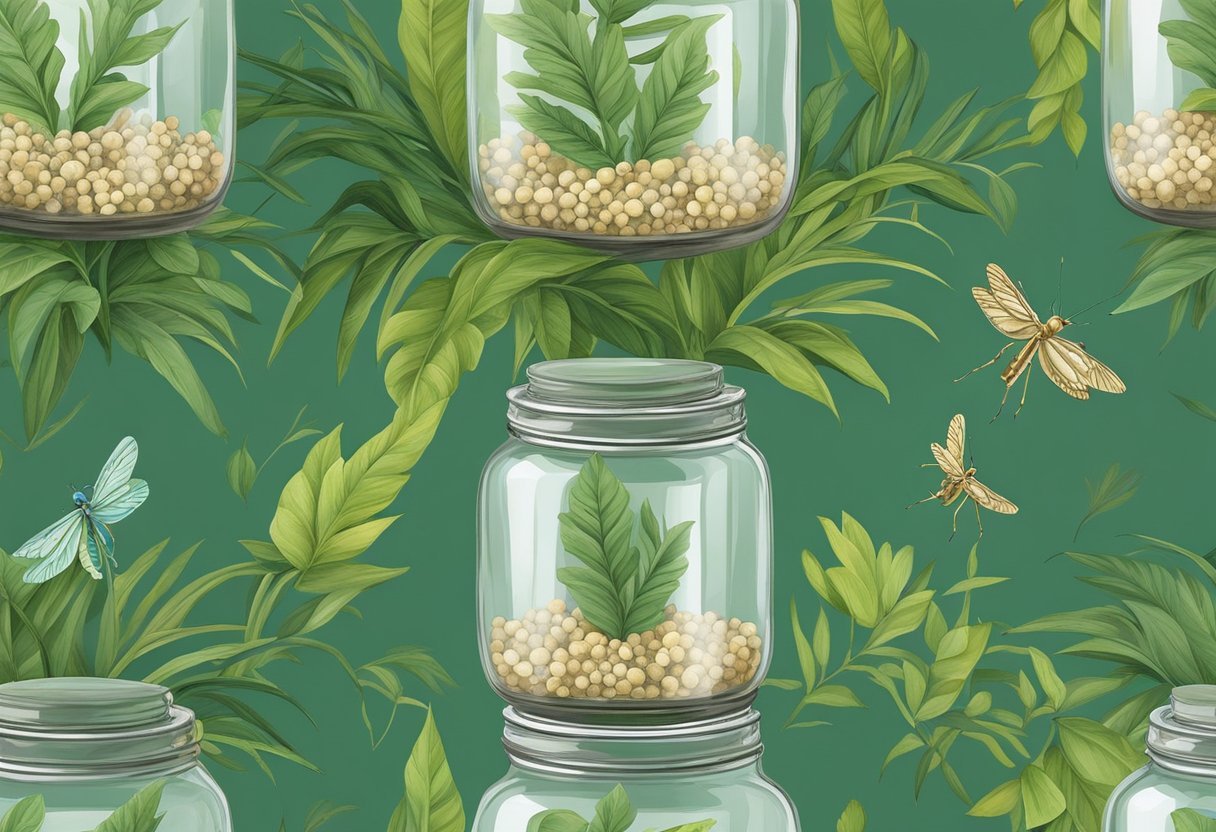
Upcycled containers need thoughtful adjustments to keep mantises safe and healthy. Small differences in container size, ventilation, or interior design can greatly impact a mantis’s comfort and well-being.
Adjusting for Different Mantis Species
Different mantis species have unique needs regarding space, humidity, and climbing surfaces. For example, Hierodula species prefer vertical containers at least three times their body length, while Gongylus gongylodes (the Ghost mantis) requires more horizontal space and extensive ventilation.
A simple comparison table can guide selections:
| Species | Minimum Height | Humidity | Ventilation | Special Needs |
|---|---|---|---|---|
| Hierodula | 20 cm | Moderate | Side/top vents | Strong branches, sturdy walls |
| Phyllocrania paradoxa | 18 cm | Slightly dry | Mesh panels | Multiple twigs, camouflaged areas |
| Deroplatys desiccata | 20 cm | High | Humid control | Leaf litter, broad perches |
Use mesh, drilled holes, or recycled screens to fine-tune airflow. Mantis habitats should include perches or sticks fixed securely so the mantis can hang upside down for molting.
Accommodating Mantis Life Stages
A mantis’s age and size affect its enclosure needs. Newly hatched mantises (nymphs) require tightly sealed containers with fine mesh ventilation and gaps no larger than 1 mm to prevent escape.
Nymphs do best in smaller spaces to make hunting easier. As they grow, upcycled containers must scale up in height and branch diameter to support larger, heavier mantises.
A practical approach involves preparing a series of containers in different sizes using washed food jars, drink bottles, and storage bins. Quick-swapping mantises to larger homes reduces injury risk and stress during molts. Adding climbing structures using natural or synthetic materials provides secure molting points at every stage.
Sustaining a Healthy Environment
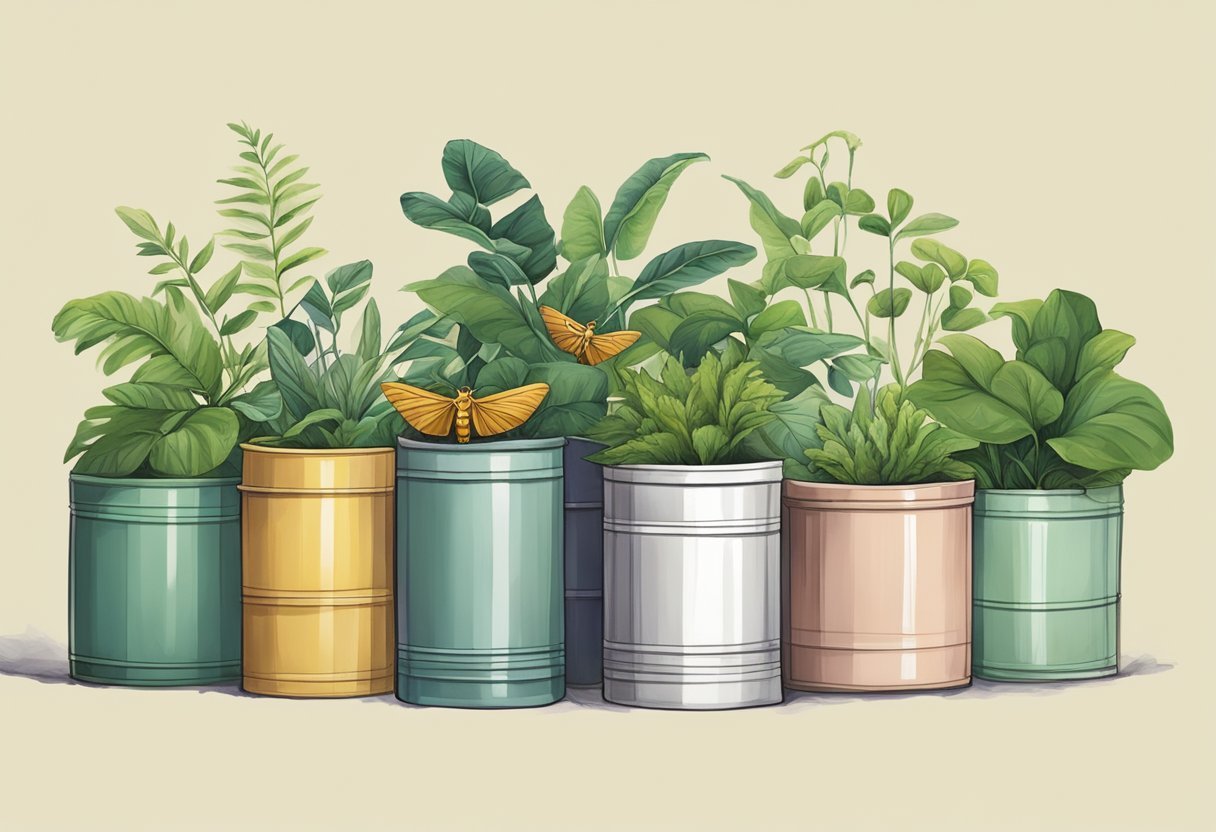
Proper environmental control and regular cleaning are critical for mantis health in upcycled containers. Fluctuations in temperature or lapses in hygiene can quickly lead to stress or disease.
Monitoring Temperature and Humidity
Mantises depend on stable temperatures, usually between 22°C to 28°C (72°F to 82°F), for healthy development. Keeping a small thermometer inside the container allows owners to spot dangerous temperature changes. Homemade containers often lack natural insulation, so keeping the enclosure away from drafts, heaters, or direct sunlight is important.
Humidity needs can vary by species, but most mantises thrive at 50% to 70% humidity. Using a hygrometer provides accurate readings. To increase humidity, a daily light misting with dechlorinated water often works well. Containers should have ventilation holes to prevent mold and ensure air exchange, but not so many that humidity regularly drops too low.
Key Tools Table:
| Tool | Purpose |
|---|---|
| Thermometer | Track temperature |
| Hygrometer | Monitor humidity levels |
| Spray bottle | Maintain humidity |
| Ventilation grid | Allow airflow |
Maintaining Cleanliness Over Time
Cleanliness minimizes the risk of pathogens and pests inside upcycled mantis habitats. Uneaten prey, shed skins, and waste must be removed every 1 to 3 days. Spot-cleaning with tweezers is effective for daily upkeep.
A full cleaning should occur every 2 to 4 weeks. Remove the mantis to a temporary enclosure and wash the main container with mild, unscented soap and warm water. Avoid using harsh chemicals, as residues may harm the mantis.
Any natural décor—such as sticks or bark—should be rinsed and dried before being replaced. Substrates like paper towel or coconut fiber should be switched out regularly. Keeping a cleaning schedule helps prevent forgotten tasks and maintains consistent hygiene.
Creative Upcycling Ideas and Inspiration
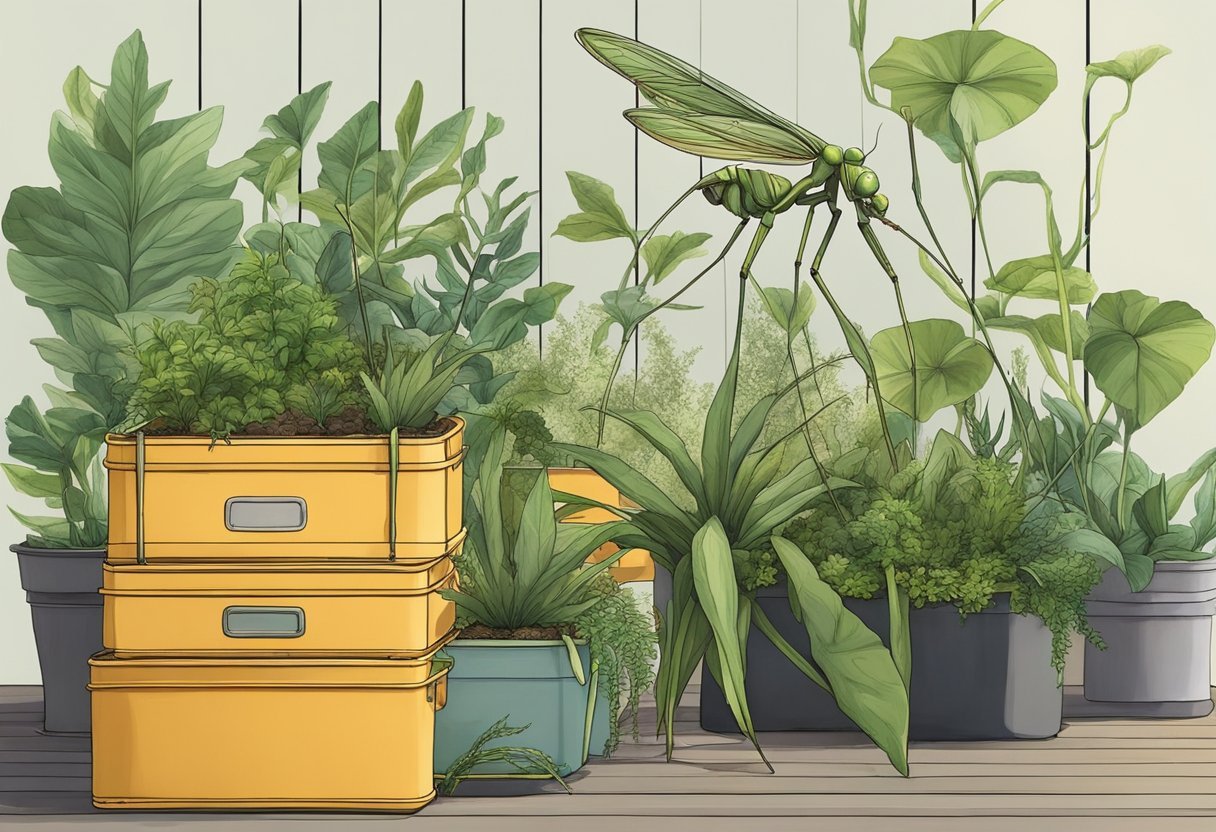
Glass Jars: Clean glass jars make excellent mantis enclosures. They are clear, easy to sanitize, and usually come with secure lids.
Plastic food containers, such as salad clamshells or takeout boxes, can be modified with air holes. These are lightweight and stackable for multiple mantises.
Old terrariums and unused fish tanks can be repurposed for larger mantis habitats. Adding mesh or screen provides extra ventilation.
| Container Type | Benefits | Modifications Needed |
|---|---|---|
| Glass jars | Clear, sturdy | Add air holes to lid |
| Plastic boxes | Lightweight | Drill or punch ventilation |
| Food tins | Durable | Secure mesh top, rust check |
Cardboard tubes from paper towels can be stacked to create climbing areas inside upcycled homes.
Empty spice jars offer mini habitats for tiny or juvenile mantises. Mesh can be glued onto the opening for airflow.
For extra style, decorative labels or non-toxic paints give each enclosure a unique look. Just avoid harmful adhesives and use only safe materials.
Quick upcycling ideas:
- Mesh laundry bags as lid covers
- Plastic bottles with the tops cut off and edges sanded smooth
- Cookie tins lined with wax paper and topped with mesh
The best options are easy to clean and allow for clear observation. Multiple containers can be arranged neatly on shelves or windowsills.
Common Mistakes to Avoid in Upcycled Mantis Homes
Improper ventilation is a frequent mistake. Mantises need good airflow to stay healthy, but many upcycled containers are airtight. Always ensure there are enough air holes, but keep them small to prevent escapes.
Some containers retain heat or get too cold quickly. Materials like metal or thin plastics might fluctuate in temperature, stressing mantises. It’s best to use containers that provide a stable internal environment.
Common issues to watch for:
- Sharp Edges: Cut or drilled plastic can leave sharp bits. Smooth or sand all edges before use.
- Toxic Residues: Soap, food, or chemical residues can harm mantises. Thoroughly clean and rinse all containers.
- Improper Size: Too small of a container restricts movement and growth. Too large can make it hard for mantises to find prey.
| Mistake | Problem Caused | How to Prevent |
|---|---|---|
| Poor ventilation | Mold, illness | Drill air holes |
| Dirty containers | Health risks | Clean thoroughly |
| Inadequate lid | Escapes, injury | Use a secure, ventilated lid |
| Reusing plastics that degrade | Cracking, leaks | Inspect and replace as needed |
Too little vertical space is another common oversight. Mantises climb and need height for molting. Choose containers that are taller than they are wide.
Failing to provide perches or rough surfaces is also a problem. Smooth-walled containers do not allow mantises to grip or molt properly. Add safe, clean sticks or mesh for climbing.
Conclusion
Using upcycled containers for mantis habitats combines practicality with sustainability. By choosing containers already available at home, keepers can reduce waste and limit expenses.
Key advantages:
- Customizable sizes for mantises at every life stage
- Variety of materials: plastic jars, glass bottles, and food containers
- Creative opportunities for decoration while maintaining function
Proper ventilation, secure lids, and easy access for cleaning remain essential. Safe materials and well-designed access points help support mantis welfare over time.
A simple table highlights some popular choices:
| Container Type | Pros | Cons |
|---|---|---|
| Plastic Jars | Lightweight, safe | May scratch or cloud |
| Glass Bottles | Clear view, durable | Heavier, breakable |
| Food Containers | Easy to find, cheap | Varies in quality |
With thoughtful selection and minor modifications, upcycled enclosures can provide mantises with safe, functional, and visually appealing homes. By reusing containers, keepers also contribute to a more resourceful approach to pet care.
Frequently Asked Questions
Choosing upcycled containers for mantis habitats requires careful consideration of material safety, ventilation, and cleanliness. Practical steps can help create functional, healthy spaces for mantises using household or recycled items.
What materials are safe to use when building a mantis enclosure from upcycled containers?
Glass, clear food-grade plastics (such as PET or PP), and untreated metal are generally safe. Avoid containers that once held toxic substances or have strong chemical residues. Painted or coated surfaces should be checked for lead or other hazardous chemicals, especially in older items.
How can mesh be integrated into a DIY mantis habitat to ensure proper ventilation?
Fine mesh, such as stainless steel or polyester window screen, can be cut to fit lid openings or side panels. Secure the mesh with hot glue, aquarium-safe silicone, or non-toxic epoxy. Ensure there are no sharp edges or gaps where a mantis could escape or get injured.
What are the best practices for maintaining hygiene in a mantis home made from recycled materials?
Before use, wash containers thoroughly with hot water and mild, fragrance-free soap. Rinse and dry completely. During use, spot clean any uneaten food or waste daily with tweezers or a paper towel. Perform a full clean using soap and water every few weeks, or sooner if mold is spotted.
Are there any specific considerations for the size and space of a homemade mantis enclosure?
The enclosure should be at least three times the length of the mantis in height and two times in width. This allows enough room for molting, hunting, and movement. Overly large enclosures can make feeding difficult, while cramped spaces heighten stress and the risk of injury.
What factors should be taken into account to provide adequate climbing and hiding spaces for mantises in upcycled enclosures?
Add vertically-oriented sticks, clean branches, or mesh strips for climbing. Include foliage made from clean, untreated fake plants or live, pesticide-free plants. Offer pieces of bark or folded cardboard for hiding, making sure all additions are clean and fit securely.
How often should upcycled mantis homes be cleaned to ensure the health and safety of the insects?
Spot cleaning for waste and leftover food should be done daily or every other day. A thorough cleaning, involving removal of all accessories and scrubbing the container, should be carried out every two to four weeks. Replace any materials showing mold or decay immediately.